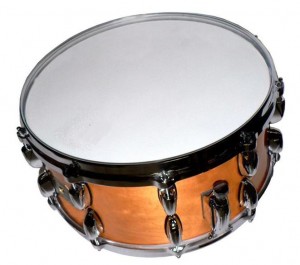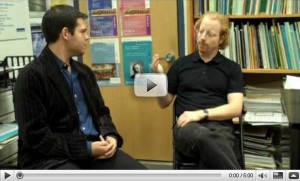
I walk into my office to a large stack of music on my desk, and my stomach turns over as I anticipate a collection of outlandish instrument requests by the composer. I can’t help but chuckle as I read down the list: propeller engine, guillotine sound, the bay of a Central American burro (alright, I made the last one up). Composers’ demands are getting stranger and stranger.
It comes with the job. Finding these instruments—or at the very least, a way to imitate the required sound—should be a challenge. These days, with all the wonderful technology available, it can be as simple as finding the correct sound effect or synthesized instrument on the Internet and playing it through a computer hooked up to an amp (this strategy proves useful when playing Harry Partch’s music). It’s a quick fix, but does it too often take some of the artistry out of what we do?
View Full Article »
Archive for the ‘Features’ Category
Guest Article: Just Press “Enter”: Technology and the Percussionist
Written by Daniel Cathey
Exclusive: Interview With Conductor Jeffery Meyer
Johannes Approves

Today’s interview is with Dr. Jeffery Meyer. He is the Director of Orchestras at Ithaca College, Artistic Director of the St. Petersburg Chamber Philharmonic, and Artistic Director of the Water City Chamber Orchestra. Meyer will lead the opening performance of Ithaca College’s 09-10 season tomorrow night, Saturday October 3rd. One of the works on the program is Jeu de Timbres by Steven Stucky, who we interviewed yesterday (see his interview here).
Also scheduled is Ravel’s Ma Mère l’Oye (Mother Goose Suite), and Berlioz’s Symphony Fantastique, op. 14. The concert takes place tomorrow night, Saturday October 3rd, at 8:15pm in Ford Hall, Ithaca College.
Please click on through for the video interview and full written transcript.
View Full Article »
Exclusive: Interview With Steven Stucky
The Sound Post Welcomes Ian Salmon

Our very own Ian Salmon conducted an exclusive interview with composer Steven Stucky regarding the performance of his work, Jeu de Timbres. The piece will be performed by the Ithaca College Symphony Orchestra this Saturday, October 3rd, 2009 in Ford Hall at Ithaca College under the direction of Dr. Jeff Meyer. Click to the full article for the video and transcript of the interview.
This is the premier of our video blog series, and will be followed by another interview tomorrow, October 2nd, 2009, with Ithaca College Director of Orchestras Jeff Meyer. So stay tuned, and keep an eye on our new videos page.
View Full Article »
Gilbert Leads NY Phil as Music Director
Mother probably proud
Alan Gilbert reigned over the New York Philharmonic tonight for the first time as music director. Hosted by actor Alec Baldwin, the televised broadcast “Live from Lincoln Center” allowed millions to watch not only the NY Phil’s opening night, but its venture into a new era of leadership. Gilbert is not only the youngest-appointed music director, but also the first native New Yorker to hold the position.
The program began with the world premier of EXPO by Magnus Lindberg, the Phil’s composer-in-residence until 2011. Lindberg wrote the work knowing it would open the milestone season—the Phil’s 50th at Avery Fisher Hall.
EXPO was followed by Songs pour Mi—a song cycle by Olivier Messiaen. Sung by Renée Fleming, the song cycle is a portrait of Messiaen’s love for his wife, Claire Delbos, who he nicknamed Mi. Those watching the televised broadcast saw Fleming introduce the cycle with a pre-recorded speech, which outlined Messiaen’s relationship from his marriage to Delbos at 27 years old, to her institutionalization due to mental illness after the end of World War II.
Finally, the headlining work of the night was Symphony No. 1—or the Fantastic Symphony—by Hector Berlioz. Written only three years after Beethoven’s death, the work facilitated the exodus into Romanticism, as it’s massive orchestration and lush expression brought unrestricted emotive composition into the musical world. The work is programmatic—that is, it possesses a narrative—with notes written by Berlioz himself. Each of the five movements has a descriptive title, including the famous March to the Scaffold and Dream of a Witch’s Sabbath. As described by Berlioz, the piece tells the story of “an artist gifted with a lively imagination” who has “poisoned himself with opium” in the “depths of despair” out of “hopeless love.”
New Works by Deak and Sinco Performed in New York
After, Deak Hurries Off to Play Maazel’s Final Performance
NEW YORK, NY — Associate Principal Bassist of the New York Philharmonic Jon Deak came forward, applauding, to shake the hands of musicians led by conductor Thomas Carlo Bo after they completed a performance his composition Lad, a Dog (Part II: The Visitor). The work is a one movement piece, performed by two narrators, violin, clarinet, and piano. Originally, the work featured only the three instrumentalists. They were to narrate the text themselves as per directions in the score. Furthermore, it was chamber music—no conductor required. This performance, however, definitely benefited from both the narrators and the conductor. While I never witnessed the chamber music version, I do think the additions improved the effectiveness of the piece. View Full Article »
Hilary Hahn Rocks New York
Probably Tired After
New York, NY — Hilary Hahn played an elegant yet cerebral set of works by Ysaye, Ives, Brahms, and Bartok at Town Hall in New York City on Sunday June 14, 2009. The concert was part of the Free For All at Town Hall concert series; a free concert series sponsored by various patrons and organized by Twin Lions, Inc.
Ms. Hahn opened with the Ysaye Solo Sonata No. 4—the fourth in a set of six sonatas composed by the Belgian composer Eugene Ysaye. Modeled after the famed six sonatas and partitas written by J.S. Bach, the Ysaye sonatas maximize the versatility of the violin itself, and tax the ability of the performer in both technique and musicianship.
Hahn demonstrated her command over her instrument by delivering a compelling and technically commendable performance. Wielding her signature clear tone, Hahn treated every note with tenderness—from its beginning to its end. In fact, the one time an incoming landing appeared it might bounce, she placed the bow with the same precision that graced the whole performance.
View Full Article »





